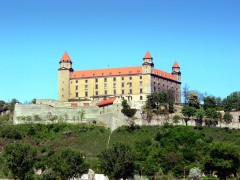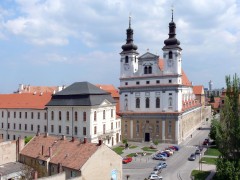Habsburg rule 16th to 18th centuries
At the beginning of the 16th century, Hungary and all of Central Europe began to lag behind Western Europe. Feudalism gained strength and the towns began to stagnate. From 1516 the legal order Opus Tripartitum broadened the privileges of the aristocracy and took away personal freedom from serf farmers. The latter were declared to be ‘eternally’ attached to the soil, they could not move, their duties grew and their human dignity was limited. That is why the period from the 16th up to the 18th centuries is referred to as the period of the second serfdom.
After the defeat of the Magyars near Mohacs (1526), where young King Louis II also died, the Ottoman Empire became the new power in the Danube region. It soon annexed the south and central parts of Hungary and Transylvania became its vassal principality.
Royal Hungary was reduced to Slovakia and a strip of land near the Austrian border. That is why these territories and their population carried the main weight of the anti-Turkish fight. A protective line of approximately 70 castles and modern Renaissance fortresses was built in southern Slovakia, on the border of the ‘Christian and Muslim worlds’, to guard against further penetration by the Turks. Komárno, situated on both banks of the Danube, is one of the best known and most precious of these fortresses, even today. Mercenaries from all over Europe lived and worked in Komárno and other strongholds during this period.
 In 1536 Bratislava was designated the new capital of Hungary, becoming part of the Habsburg (Austrian) monarchy and marking the beginning of a new era. The Hungarian parliament met here and Bratislava (known in German as Pressburg) became the coronation site for Hungarian kings and queens. The Hungarian primate of Ezstergom also moved to Trnava for three centuries.
In 1536 Bratislava was designated the new capital of Hungary, becoming part of the Habsburg (Austrian) monarchy and marking the beginning of a new era. The Hungarian parliament met here and Bratislava (known in German as Pressburg) became the coronation site for Hungarian kings and queens. The Hungarian primate of Ezstergom also moved to Trnava for three centuries.Now occupying both the Hungarian and Czech thrones, the Austrian Habsburgs began to integrate Central Europe into a multi-ethnic empire. However, their centralist policies and absolutism aroused resistance among the Hungarian aristocracy, and the religious situation only served to complicate matters.
During the 16th century the protestant reformation (represented amongst the Magyars by Calvinism) spread among the Slovaks and Germans in Hungary, and the rest of the population, including the aristocracy and citizens of the royal towns, soon joined them. By the start of the 17th century, thanks to Palatine Juraj Thurzo (Thurzó György), the evangelical church was firmly established in Hungary, notably in Žilina and Spišské Podhradie. At first the religious dualism did not cause any significant conflicts. However, when the Habsburgs and the Catholic church began to promote re-Catholisation and centralism, rifts began to develop.
During the 17th century Slovakia was shaken by no fewer than five anti-Habsburg uprisings. Aristocratic rebels demanded the preservation of their privileges (tax-free status, the right to elect a Hungarian king, summoning of the parliament) and independence for Hungary; they also defended the religious freedom of Protestants, although they frequently subjected Catholics to the same persecution that the Protestants had suffered.
 The religious struggle indirectly aided the growth of education. Trnava became the centre of re-Catholisation in Hungary and a model Baroque town, where in 1635 a Jesuit University was established. A similar university also operated in Košice. Catholic and evangelical lyceums (gymnasiums) and municipal schools were also built. The evangelical lyceum in Prešov was of excellent quality. Use of the domestic language in teaching, in the administration of estates and in guilds and literary works also spread. Interest in the history of Slovaks grew among the scholars, who began to cultivate the Great Moravian tradition. Part of the high and middle aristocracy began to use the Slovak language along with Latin, German and Hungarian.
The religious struggle indirectly aided the growth of education. Trnava became the centre of re-Catholisation in Hungary and a model Baroque town, where in 1635 a Jesuit University was established. A similar university also operated in Košice. Catholic and evangelical lyceums (gymnasiums) and municipal schools were also built. The evangelical lyceum in Prešov was of excellent quality. Use of the domestic language in teaching, in the administration of estates and in guilds and literary works also spread. Interest in the history of Slovaks grew among the scholars, who began to cultivate the Great Moravian tradition. Part of the high and middle aristocracy began to use the Slovak language along with Latin, German and Hungarian.The defeat of the Turks near Vienna in 1683 provided the impulse to push the Turks out of Hungary entirely, and three years later Buda and Pest were reconquered. Then in 1711 the Habsburgs defeated the last and the largest uprising by Ferencz Rákoczi II, Prince of Transylvania, and a period of peace finally began. However, Hungary had been devastated and was exhausted by the long fights. The fertile lower land in the south was half empty. That is why from the end of the 17th century, masses of farmers, including Slovaks, began to move there legally and secretly from various areas of the country. They acquired new land, greater freedom, settled old municipalities and established new ones, and gradually created a number of Slovak enclaves of various sizes. And so the Slovak ethnic space grew.
However, the ethnic diversity of the territory of Slovakia also grew at this time. After the split of Poland, Jews settled in Slovak territory, and in the 19th century as a result of Magyarisation and migration, the number of Hungarians also increased rapidly.
In the 18th century, Empress Maria Theresa (1740-1780) and her son Emperor Joseph II (1780-1790) tried to rebuild their incoherent empire into a unified state; they also tried to modernise it through brave Enlightenment reforms based on the western model. Thanks to the investments of imperial Vienna in the area of central Slovakia, the mining of precious metals increased and a number of new technical inventions were used. Manufacturing was established and the foundations of compulsory school attendance were introduced. In Banská Štiavnica, the first mining university in the world (1763) was established. Joseph II abolished serfdom and granted religious and civil rights to Protestants and orthodox Christians. However, he was unsuccessful in his attempts to introduce universal taxation, weaken the privileges of Hungarian aristocracy, nationalise the public administration in Hungary and thus integrate it more firmly within the monarchy.
During this same period the aristocracy built comfortable mansions in villages and palaces in large towns. Bratislava in particular experienced a significant construction boom. However, in 1783 Joseph II made Buda once more the capital of Hungary, moving the main government offices from Bratislava and the university from Trnava. Thereafter the significance of Buda and central Hungary began to grow. Conversely, the significance of Bratislava and Slovakia, with their population of 2 million people, began to wane.
